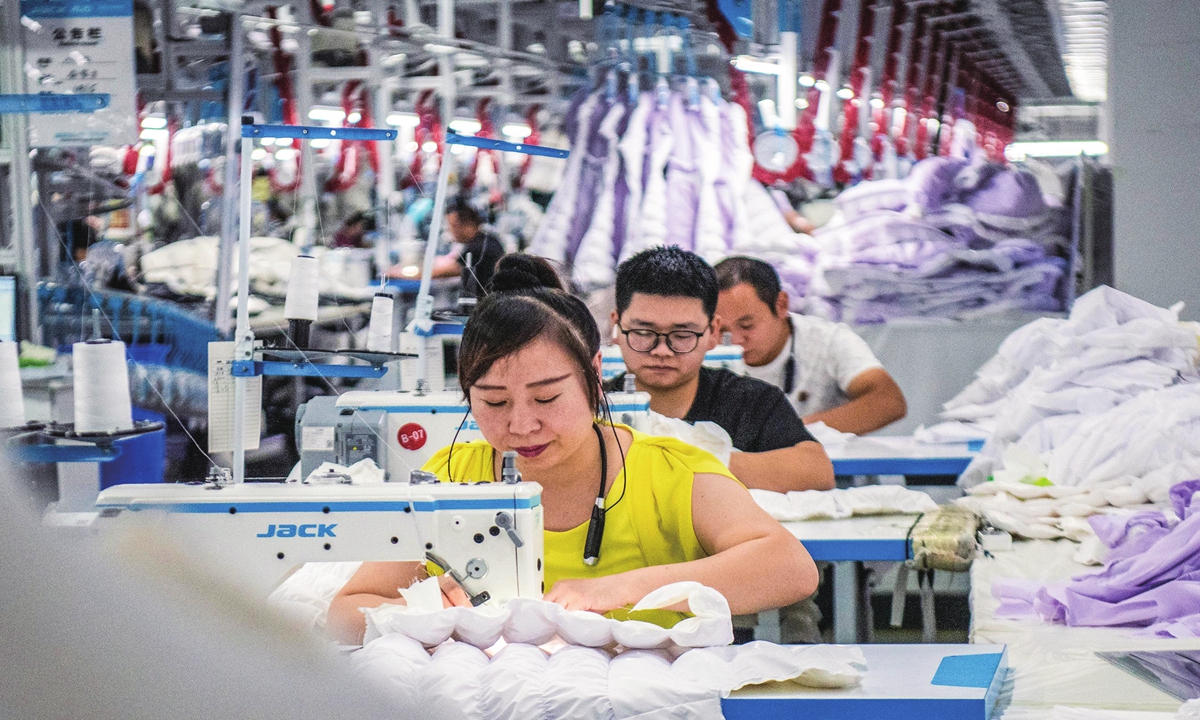
Workers are busy producing export-oriented clothes ordered by overseas clients at a garment factory in Suncun town in Wuhu city, East China’s Anhui Province on August 29, 2023. From January to April this year, China's overall exports of textiles, clothing and accessories totaled $92.88 billion, according to the General Administration of Customs of China. Photo:cnsphoto
China' s industrial production is expected to further stabilize amid the country's ongoing economic recovery, market expansion and continuing structural adjustment, as the added value of industrial enterprises above designated size recorded a 4.5 percent year-on-year increase in August, 0.8 percentage points faster than July's growth, according to the National Bureau of Statistics (NBS) on Friday.
The 4.5-percent growth beat expectation for a 3.9 percent increase in a Reuters poll, and is the quickest pace since April. In the first eight months of 2023, the added value of industrial enterprises above designated size increased by 3.9 percent year-on-year, according to the NBS.
Upgrade in the manufacturing sector has continued to advance steadily, which contributed to strengthening the foundation for the real economy, Fu Linghui, a NBS spokesperson, told a press conference. For instance, industrial output of integrated circuit products reached a year-on-year increases of 21.1 percent.
Fu also attributed the positive changes to a boost from green transformation and accelerated growth of equipment manufacturing and raw materials on the back of an extended market rebound.
The added value of the equipment manufacturing sector increased by 5.4 percent year-on-year, 2.1 percentage points faster than July, while the figure for raw materials manufacturing grew by 10.4 percent compared with last year.
Fields related to new energy have maintained a rapid growth in August, injecting new impetus for the domestic industrial development. The output for new-energy vehicles increased by 13.8 percent on a yearly basis in August.
Fu also noted that more positive factors were seen in promoting the steady operation of industrial production, including improving market demand.
For example, the sub-index tracking new orders under the manufacturing purchasing managers' index (PMI) rose to 50.2 percent, bouncing back to the expansion territory for the first time since April. At the same time, the decline of producer price index (PPI) - a main gauge of factory prices - further narrowed in August which also contributed to the improvement in corporate profitability.
On the outlook for the PPI in the second half of 2023, which turned positive for the first time in August, Fu said that the decline is likely to further narrow thanks to improving domestic demand. He noted that the expected rebound of the PPI will play a positive role in improving the production and operation of enterprises, boosting confidence in sustained economic development.
Going forward, Fu stressed that industrial output will likely maintain stable operation despite a complicated external environment, as policies to boost the demand will further take effect on top of a steady industrial upgrading and strengthening new development driver.
The decline in profits of industrial enterprises above designated size had also narrowed in the first seven months, thanks to improving market demand, easing cost pressure for enterprises and rising profit in key industries. As macro policies continue to take effect, demand expands and prices rebound, overall profitability of enterprises will be improved, Fu said.
Global Times
